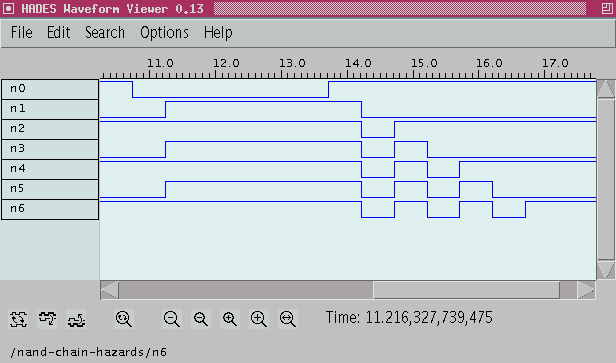

Applets
contents
visual index
 introduction
introduction std_logic_1164
std_logic_1164 gatelevel circuits
gatelevel circuits delay models
delay models
 gate vs. wir...
gate vs. wir...
 gate delay d...
gate delay d...
 ring oscillator
ring oscillator
 hazards
hazards
 NAND-chain
NAND-chain
 D-flipflop h...
D-flipflop h...
 clock-doubler
clock-doubler
 2-phase cloc...
2-phase cloc... flipflops
flipflops adders and arithm...
adders and arithm... counters
counters LFSR and selftest
LFSR and selftest memories
memories programmable logic
programmable logic state-machine editor
state-machine editor misc. demos
misc. demos I/O and displays
I/O and displays DCF-77 clock
DCF-77 clock relays (switch-le...
relays (switch-le... CMOS circuits (sw...
CMOS circuits (sw... RTLIB logic
RTLIB logic RTLIB registers
RTLIB registers Prima processor
Prima processor D*CORE
D*CORE MicroJava
MicroJava Pic16 cosimulation
Pic16 cosimulation Mips R3000 cosimu...
Mips R3000 cosimu... Intel MCS4 (i4004)
Intel MCS4 (i4004) image processing ...
image processing ... [Sch04] Codeumsetzer
[Sch04] Codeumsetzer [Sch04] Addierer
[Sch04] Addierer [Sch04] Flipflops
[Sch04] Flipflops [Sch04] Schaltwerke
[Sch04] Schaltwerke [Sch04] RALU, Min...
[Sch04] RALU, Min... [Fer05] State-Mac...
[Fer05] State-Mac... [Fer05] PIC16F84/...
[Fer05] PIC16F84/... [Fer05] Miscellan...
[Fer05] Miscellan... [Fer05] Femtojava
[Fer05] Femtojava FreeTTS
FreeTTS Note that circuit structures like this should be avoided
even if the rest of the system is designed to tolerate the hazards,
because the high amount of switching also implies a lot of
power consumption - at least for CMOS technology.
In fact, the most advanced logic synthesis systems include the option
to prefer low power consumption over low number of gates.
Challenge: Design a circuit that creates the maximum number of
hazards per number of gates :-)
Note that circuit structures like this should be avoided
even if the rest of the system is designed to tolerate the hazards,
because the high amount of switching also implies a lot of
power consumption - at least for CMOS technology.
In fact, the most advanced logic synthesis systems include the option
to prefer low power consumption over low number of gates.
Challenge: Design a circuit that creates the maximum number of
hazards per number of gates :-)